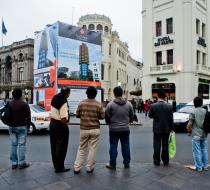Los Palcos del Descubridor (The discoverer's box seats) Favorite
"Los Palcos del Descubridor" (The Discoverer's Box Seats) was a project created by Sebastian Burga and José Aburto in 2012 that consisted of a large-scale installation on the street and a media campaign on the Internet.
The work simulated the upcoming construction of an apartment building that would replace Lima's Teatro Colón, a historical landmark.
The project generated great attention from the press, neighbors, and social media. More than 500 calls were received requesting an apartment.
Since 1914, the Colón Theater has been one of the most important buildings in the city. Yet today, it is just an abandoned shell. This contrasts with a city looking for vertical growth opportunities due to a real estate boom, a process that came hand in hand with the gentrification of previously abandoned spaces.
The work was ironic, using the concept of Christopher Columbus and turning the Teatro Colón into "The Discoverer's Box Seats" with an architectural design in the shape of corn, a plant native to the Americas. The main piece was a 6-meter-high poster that covered the theater and announced the future building.
Additionally, as part of the work, a movement was created on social media against the building called "No al Choclo Colón," which generated controversy about the need to respect historical spaces in the city.
- - - -
[Versión en Español]
“Los palcos del descubridor” consistió en una propuesta artística de instalación a gran escala en calle, website, volantes, aviso de prensa y redes sociales que se realizó con el financiamiento del concurso Centro Abierto 2012. La obra simulaba la próxima construcción de un edificio de departamentos como reemplazo del Teatro Colón. La propuesta generó gran atención de la prensa, los transeúntes y las redes sociales. Más de 500 llamadas fueron recibidas solicitando departamentos dentro del proyecto.
Desde 1914, el teatro Colón es uno de los edificios con mayor importancia de la ciudad. Sin embargo, hoy es solo un cascarón abandonado. En contraste con una ciudad en busca de oportunidades de crecimiento vertical debido al boom inmobiliario. Este proceso vino de la mano de la gentrificación de espacios antes abandonados.
La obra ironizaba con el concepto de “Cristóbal Colón” convirtiendo el “Teatro Colón” en “los palcos del descubridor” con un diseño arquitectónico en forma de maíz, planta originaria de las Américas. La pieza principal era un cartel de 6mt de altura que tapaba el teatro y anunciaba el futuro edificio. También, como parte de la obra, se creó un movimiento en social media contra el edificio llamado “No al Choclo Colón” que generaba polémica sobre la necesidad de respetar espacios históricos de la ciudad.








